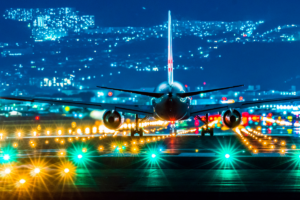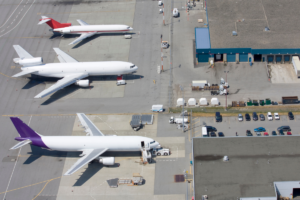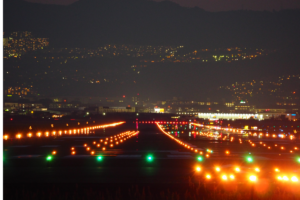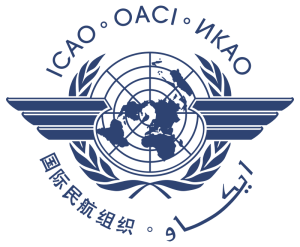Lorsque les frères Wright ont réussi à prendre leur envol en 1903, ils se sont uniquement attachés à faire décoller leur "machine volante" et à la maintenir en vol le plus longtemps possible. Ils ne pouvaient pas se rendre compte à l'époque que la révolution technique à laquelle ils venaient de donner naissance ne concernait pas seulement l'aviation elle-même, mais aussi les innovations entourant la sécurité des opérations aéroportuaires, en particulier lors des atterrissages.
Le système de balisage des pistes est un élément essentiel de la sécurité aéroportuaire. Il indique généralement aux pilotes le bord de la piste, le seuil, l'axe et la zone de toucher des roues. Grâce à ce système de balisage, les risques d'accident sur le tarmac pendant le décollage, l'atterrissage et le déplacement des avions sont réduits au minimum, en particulier la nuit et lorsque la visibilité est mauvaise à d'autres moments.
L'industrie du transport aérien s'est développée au cours du siècle dernier, avec plus d'avions commerciaux en vol que jamais auparavant, et le besoin de solutions de balisage des pistes plus technologiques s'est fait sentir. La bonne nouvelle, c'est que la technologie du balisage des pistes a considérablement évolué depuis la première installation de systèmes de balisage d'approche dans les années 1930.
Examinons quelques-unes des technologies qui ont le plus changé la donne dans le domaine de l'éclairage des aéroports et qui sont utilisées aujourd'hui.
Technologie LED
Demandez à n'importe quel expert en éclairage : aucune innovation récente n'a autant transformé son secteur que la technologie des diodes électroluminescentes (DEL). Les aéroports ont utilisé des ampoules halogènes pour éclairer leurs pistes d'atterrissage pendant plusieurs décennies, jusqu'à ce que les diodes électroluminescentes mettent un terme à leur utilisation.
La révolution des LED ne s'est pas produite uniquement pour le plaisir du changement ; les LED offrent aux aéroports plusieurs avantages tangibles que les autres lampes ne peuvent tout simplement pas offrir. Par exemple, les LED consomment jusqu'à 75 % d'énergie en moins que les ampoules à incandescence ou halogènes, ce qui représente des économies d'énergie considérables pour les exploitants d'aéroports, d'autant plus que de nombreux systèmes d'éclairage de pistes fonctionnent 24 heures sur 24 et 7 jours sur 7.
En outre, les LED affichent des heures de service supérieures à 50 000 et, dans certains cas, à 100 000 heures, contre seulement 2 000 heures pour les lampes halogènes, ce qui permet aux aéroports de réaliser des économies en réduisant la fréquence de remplacement des ampoules. Elles sont également plus durables que les lampes halogènes et moins susceptibles d'être endommagées par des vibrations importantes, des conditions météorologiques défavorables ou des chocs physiques, autant de problèmes courants sur les pistes d'atterrissage.
Plus important encore, les LED améliorent la sécurité des avions. Grâce à leur rendement lumineux supérieur et à la précision de leurs couleurs, les marquages et les panneaux de signalisation des pistes et des voies de circulation sont visibles même dans l'obscurité, le brouillard, la pluie et la neige.
Systèmes d'éclairage adaptatif
À l'époque où notre industrie n'en était qu'à ses balbutiements, le balisage des pistes se résumait à allumer les lumières. Cette approche a bien fonctionné pendant des décennies, mais le besoin de systèmes plus sophistiqués s'est fait sentir au fur et à mesure que l'industrie aéronautique prenait son essor, créant un trafic aérien plus important, 24 heures sur 24, dans des conditions difficiles qui affectent la visibilité des pistes.
La nécessité d'un contrôle plus dynamique de l'éclairage a donné naissance à l'éclairage adaptatif. Ces systèmes avancés utilisent des capteurs pour collecter des données sur les conditions météorologiques extérieures, telles que le brouillard, la pluie ou la neige, et augmentent automatiquement la luminosité de l'éclairage pour optimiser la visibilité des pilotes. Inversement, l'éclairage diminue lorsque le temps est clair, ce qui permet de réduire la consommation d'énergie. Un meilleur contrôle de l'éclairage permet également de réduire la pollution lumineuse, ce qui améliore la qualité de vie des communautés voisines et minimise l'effet de l'éclairage des aéroports sur les écosystèmes locaux.
L'intégration des systèmes d'éclairage des aéroports avec l'équipement de détection de surface automatisé (ASDE) est un autre exemple de la manière dont l'éclairage adaptatif peut optimiser les opérations aéroportuaires. L'ASDE surveille la présence d'aéronefs et de véhicules de surface sur les pistes et les voies de circulation, et ajuste automatiquement le balisage en fonction des conditions du trafic au sol. La possibilité d'activer des feux spécifiques pour guider le pilote d'un avion en toute sécurité le long de la piste améliore la connaissance de la situation et réduit le risque d'incursion sur la piste.
Les systèmes d'éclairage adaptatifs peuvent également être utilisés pour transmettre des données aux contrôleurs aériens, qui peuvent alors ajuster manuellement l'éclairage de l'aéroport en fonction des besoins de la situation pendant l'approche de l'avion ou les mouvements au sol.
Plus d'informations : Intégration de l'équipement de détection de surface automatisé à votre système de balisage de piste
Contrôle et surveillance sans fil de l'éclairage des aéroports
Les appareils sans fil devenant de plus en plus courants dans notre vie quotidienne, ce n'était qu'une question de temps avant que les aéroports n'adoptent la technologie sans fil pour gérer leurs systèmes d'éclairage des pistes.
Les avantages pour le commutateur sont nombreux. Par exemple, les systèmes sans fil ne nécessitent pas de réseau de câblage souterrain complexe, ce qui facilite grandement l'installation et la maintenance. En outre, la technologie permet un suivi temporel, des diagnostics et des alertes de défaillance aux techniciens de l'aéroport, qui peuvent réagir rapidement aux problèmes sans avoir à inspecter physiquement chaque lumière, ce qui réduit le temps de réparation.
La technologie de l'éclairage des aéroports continue d'évoluer à un rythme qu'il semble difficile de suivre. Si vous souhaitez découvrir les dernières nouveautés en matière de technologie d'éclairage des aéroports, s'adresser aux experts de Airport Lighting Company. Nos techniciens hautement expérimentés et qualifiés peuvent fournir des solutions pratiques et rentables en matière de balisage aéroportuaire et d'équipement électrique afin de garantir le bon fonctionnement, l'efficacité et la sécurité de vos opérations de balisage des pistes et des voies de circulation.
Appelez le Airport Lighting Company pour obtenir les dernières technologies en matière d'éclairage des aéroports
L'équipe de Airport Lighting Company est à votre disposition pour répondre à vos questions pour savoir comment nos produits technologiques peuvent contribuer à améliorer la sécurité, la fiabilité et l'efficacité de vos pistes d'atterrissage. Appelez le 315-682-6460 pour un service rapide et amical sur lequel vous pouvez compter.





